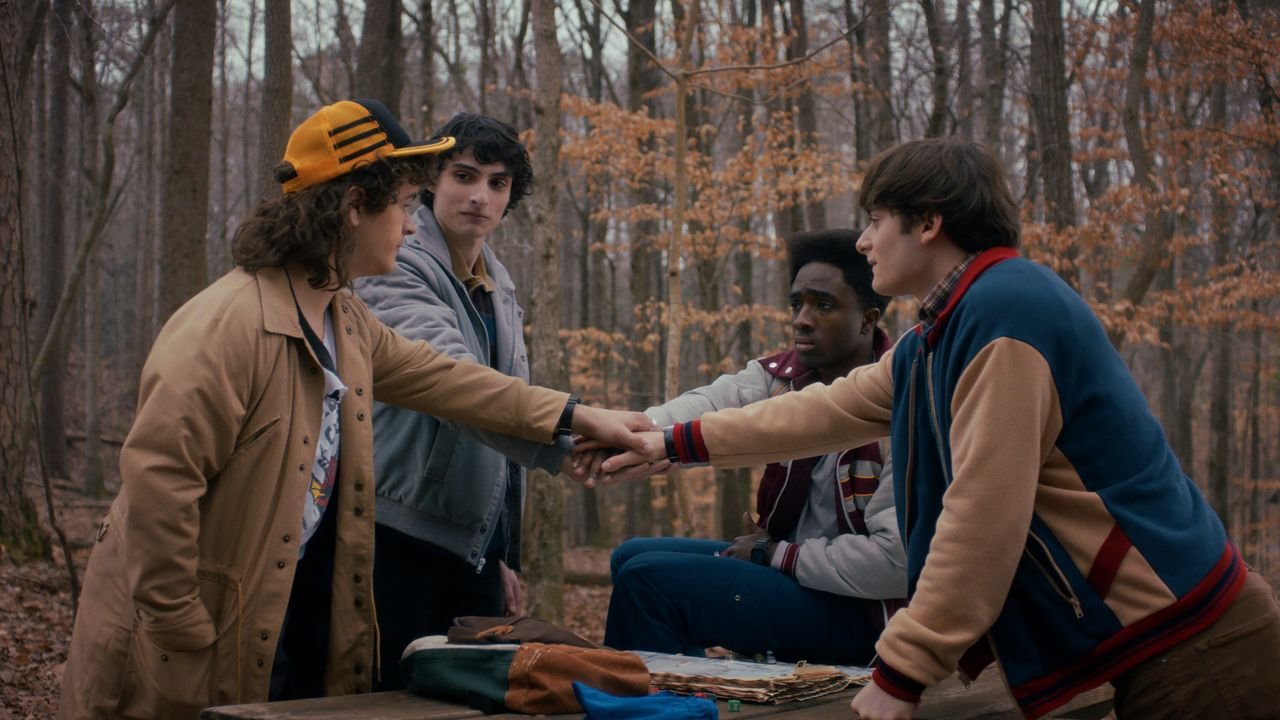Top Stories
Netflix Shares First Teaser Video for Stranger Things’ Final Season: Watch

Netflix has shared the first teaser video for the fifth and final season of Stranger Things. Here is what is promised in the new season: “The fall of 1987. Hawkins is scarred by the opening of the Rifts, and our heroes are united by a single goal: find and kill Vecna.” The synopsis continues: “The final battle is looming—and with it, a darkness more powerful and more deadly than anything they’ve faced before. To end this nightmare, they’ll need everyone—the full party—standing together, one last time.” Below, watch the new teaser video. Also below, see the official poster for the new season.
The fifth season of Stranger Things has been teased for years, and it officially went into production at the beginning of last year. The first four episodes of the new season will hit Netflix on Wednesday, November 26; the next three episodes air on Christmas; and the series finale is out on New Year’s Eve. Each suite of episodes hits Netflix on 8 p.m. Eastern Standard Time on the release date.
The first season of Stranger Things premiered on Netflix in July 2016. Since then, some of the show’s stars have embarked on careers in music, to go along with their acting gigs. Maya Hawke, for instance, has released several albums, the most recent of which, Chaos Angel, landed in 2024. Finn Wolfhard also released music with his band Calpurnia, and he shared his solo debut, Happy Birthday, last month. And Joe Keery has stayed active in Post Animal and his solo endeavor, Djo.
Top Stories
Gmail for Android getting the full M3 Expressive container treatment

After the initial wave of M3 Expressive, the Gmail for Android redesign continues by placing each email in a container.
The Material 3 Expressive redesign that widely rolled out, which Google originally showed off in May, puts your inbox (and other lists) in one container.
The latest iteration places each email in its own container. There is a small gap between every item in the list view, with the first and last message featuring a more pronounced curvature.
As always, M3 Expressive changes are more visible on your device versus screenshots.
Old vs. new
There are also borders on the left and right of the screen. With this design, there is one connected, background layer for the bottom bar, hamburger button, and account switcher.
Meanwhile, those that have this redesign are seeing the search app bar, with the initial rollout featuring the old joined one. This matches Google Drive and Keep, which are also Workspace apps.
These containers join other M3 Expressive elements in Gmail like the bubbly swipe action animations, as well as the prominent Reply and Forward buttons at the bottom of messages.
Overall, it looks like we’re in for a stretch of Google updating various aspects with more Material 3 Expressive over time. In the case of Gmail, the Compose screen and homescreen widgets are unchanged right now.
More on M3 Expressive:
FTC: We use income earning auto affiliate links. More.
Top Stories
McDonald’s to expand value menu with discounted combo meals

McDonald’s Meal Deal photographed in Washington, D.C., on Aug. 26, 2024.
Scott Suchman | The Washington Post | Getty Images
McDonald’s on Tuesday announced that it is expanding its value offerings in a bid to reach price-conscious diners.
Starting Monday, the fast-food giant is bringing back its Extra Value Meals, which were last promoted before the Covid-19 pandemic. Customers will save 15% on the combo meals compared with buying the entree, fries and a drink separately, the company said.
Tune in now: McDonald’s CEO Chris Kempczinski joins CNBC’s “Squawk Box” to discuss the fast-food giant’s expanded value menu. Watch in real time on CNBC+ or the CNBC Pro stream.
For more than a year, McDonald’s and its rivals have been relying on discounts and deals to lure customers back to their restaurants. Traffic to fast-food chains has been shrinking, fueled by a pullback in spending by low-income consumers. Last summer, McDonald’s rolled out its $5 value meal and extended the promotion past its initial run. It later added a buy one, get one for $1 deal to its menu as well.
The eight combo meals stretch across the McDonald’s menu and include a Sausage McMuffin with Egg; Sausage Egg and Cheese McGriddle; Egg McMuffin; Bacon, Egg and Cheese Biscuit; Big Mac; 10-piece Chicken McNuggets; any Quarter Pounder burger; and any McCrispy Sandwich.
To promote the expansion of its value menu, McDonald’s will sell a Sausage McMuffin with Egg with a hash brown and a small coffee for $5, and a Big Mac with medium fries and a medium soft drink for $8 for a limited time.
“McDonald’s USA is laser-focused on delivering value and affordability for our customers, and I’m incredibly proud of how our franchisees and teams continue to step up to make it a reality,” McDonald’s U.S. President Joe Erlinger said in a statement Tuesday.
On McDonald’s latest earnings conference call in early August, CEO Chris Kempczinski again underlined the fast-food sector’s reliance on visits from low-income consumers.
“Reengaging the low-income consumer is critical, as they typically visit our restaurants more frequently than middle- and high-income consumers,” Kempczinski said.
McDonald’s has more deals planned for later this year, too. Starting in November, the chain will offer its Sausage, Egg and Cheese McGriddles for $5 and 10-piece Chicken McNuggets meals for $8.
Top Stories
No suffering, no death, no limits: the nanobots pipe dream

In 2000, Bill Joy, the co-founder and chief scientist of the computer company Sun Microsystems, sounded an alarm about technology. In an article in Wired titled ‘Why the Future Doesn’t Need Us’, Joy wrote that we should ‘limit development of the technologies that are too dangerous, by limiting our pursuit of certain kinds of knowledge.’ He feared a future in which our inventions casually wipe us from the face of the planet.
The concerns expressed in Joy’s article, which prompted accusations of Luddism from tech advocates, sound remarkably similar to those now being voiced by some leaders in Silicon Valley that artificial intelligence might soon surpass us in intelligence and decide we humans are expendable. However, while ‘sentient robots’ were a part of what had spooked Joy, his main worry was about another technology that he figured might make that prospect imminently possible. He was troubled by nanotechnology: the engineering of matter at the scale of nanometres, comparable to the size of molecules.
In fact, it would be more accurate to say Joy was troubled by the version of nanotechnology that he had read about in the book Engines of Creation (1986) by the engineer K Eric Drexler, a graduate of the Massachusetts Institute of Technology. At the close of the 20th century, it was nanotechnology, not AI (which didn’t seem to be getting very far), that loomed large as the enabler of utopias and dystopias. Drexler’s book described a vision of nanotech that could work wonders, promising, in Joy’s words, ‘incredibly low-cost solar power, cures for cancer and the common cold’ as well as ‘[low-cost] spaceflight … and restoration of extinct species.’
But Joy had learnt from the inventor Ray Kurzweil (now a scientific adviser to Google) that Drexler’s nanotech promised something yet more remarkable: the singularity, a point at which our accelerating technological prowess reaches escape velocity and literal marvels become possible – in particular, immortality through the merging of human and machine, so that we could upload our minds to computers and live forever in a digital nirvana.
‘[N]anotechnology-based manufacturing devices in the 2020s will be capable of creating almost any physical product from inexpensive raw materials and information,’ Kurzweil wrote in his book The Singularity Is Near (2005). The technology ‘will provide tools to effectively combat poverty, clean up our environment, overcome disease, extend human longevity, and many other worthwhile pursuits.’
But, Joy learned, there was a downside to all this. Drexler’s nanotechnology could get out of hand, unleashing swarms of invisibly tiny nano-robots that blindly start pulling everything apart, atom by atom, until they have reduced the world to what Drexler called ‘grey goo’. In the late 1990s, the grey-goo problem was the golem that, like ‘superintelligent AI’ today, might bring about our hubristic downfall.
You might have noticed that none of this has happened. No cures for cancer, no mind-uploading immortality, but no grey goo either. This is because Drexler’s vision of nanotechnology was a chimera. It was like the philosophers’ stone of the alchemists: magic dressed in the science of its time, by means of which almost anything becomes possible. I call these oneiric technologies: they do not and quite probably cannot exist, but they fulfil a deep-rooted dream, or a nightmare, or both.
These techno-fantasies are central to the utopias regularly forecast by tech billionaires
These are not simply technologies of the future that we don’t yet have the means to realise, like the super-advanced technologies that Arthur C Clarke said we would be unable to distinguish from magic. Rather, oneiric technology takes a wish (or a terror) and clothes it in what looks like scientific raiment so that the uninitiated onlooker, and perhaps the dreamer, can no longer tell it apart from what is genuinely on the verge of the possible. Perpetual motion is one of the oldest oneiric technologies, although only since the 19th century have we known why it won’t work (this knowledge doesn’t discourage modern attempts, for example by allegedly exploiting the ‘quantum vacuum’); anti-gravity shielding is probably another.
The oneiric technologies currently in vogue in Silicon Valley include the notion of terraforming other planets, transforming their geosphere and atmosphere to render them inhabitable; cryonic freezing of your head after death so that your consciousness can one day be rebooted; and the related idea of mind-uploading to computer circuits. These techno-fantasies are central to the utopias regularly forecast by tech billionaires. They interconnect in a nexus to which Drexlerian nanotechnology is central.
It is worth looking into that particular dream, not just because of the parallels with the fantastical claims and fears about AI today, but because even now Drexlerian nanobots have not gone away. Kurzweil still cites them as the reason why his singularity is even ‘nearer’ – in 2024, he put it at 2045, at which point it will be possible to go (that is, to send nanobots) ‘inside the brain and capture everything in there.’ This implausible form of nanotechnology is still a part of Silicon Valley’s magical thinking, the aim of which, as the science writer Adam Becker says in his book More Everything Forever (2025), is to ‘tame the universe, to make it into a padded playground.’ No suffering, no death, no physical limits: a paradise shaped by ultra-libertarian – some say quasi-fascist – politics in which no one will tell you that anything is forbidden or impossible.
An enthusiast of 1970s dreams of space colonisation, Drexler began thinking about nanotechnology as an undergraduate at MIT in 1977. He was inspired by a talk by the physicist Richard Feynman titled ‘There’s Plenty of Room at the Bottom’ (1959), in which Feynman imagined engineering at extremely tiny scales too small for the eye to see – and perhaps as small as could be conceived. ‘What would happen if we could arrange the atoms one by one the way we want them?’ Feynman asked. What indeed, Drexler wondered.
In 1981, he published his core vision in the academic paper ‘Molecular Engineering: An Approach to the Development of General Capabilities for Molecular Manipulation’. But it was his book Engines of Creation five years later, a popular and non-technical account of what this capability might lead to, that made Drexler the toast of tech entrepreneurs.
Drexler imagined making a ‘molecular assembler’, a mechanical device for grabbing atoms and pushing them together like Lego bricks. It might sound absurdly difficult to achieve that level of control and precision, but Drexler argued that we already have proof of its possibility. For isn’t this just what biology does, using machines made from protein molecules to read assembly instructions encoded in DNA and turn them into the parts of living cells? You might wonder what kind of practical manufacturing could be usefully done with a molecular-scale machine, but the key to Drexler’s vision was a progressive scaling up: small machines make bigger ones, which make bigger ones. Scaling up would also borrow another trick from nature: these molecular machines would be self-replicating, being able to assemble copies of themselves. You need only make one, and it can multiply exponentially. After publishing Engines of Creation, Drexler obtained his doctorate at MIT under the supervision of the AI guru Marvin Minsky. His thesis furnished a more technical book, Nanosystems (1992), intended as the scientific blueprint for realising the wonders promised in Engines.
Kurzweil imagines nanobots whizzing around in our heads reading the electrical states of neurons
With atomic-scale manipulation and assembler replication, said Drexler, we could create anything – not, as we currently do, through crude chemical processing or the laborious ‘top down’ etching and carving needed to fashion miniaturised devices such as silicon chips but from the bottom up, atom by atom. And whereas nature’s machines – proteins – are delicate and liable to fall apart if they get too warm or cold, molecular assemblers can be made of sterner stuff. Ideally, we would make them from carbon atoms, each component then in effect a little shaped piece of pure diamond. These ‘diamondoid’ nanomachines – nanoscale robotic arms, pincers, rotors, filters and so forth – wouldn’t break or corrode, and ‘will be able to build virtually anything that can be designed.’ In his book Where Is My Flying Car? (2021), Drexler’s associate and advocate, the computer scientist and writer J Storrs Hall, estimated that with nanoassemblers one could recreate the entire physical infrastructure of the United States – roads, bridges, cities – in a single week.
Drexler’s nanotech dream, with nanoscale robots patrolling our bloodstream, killing off pathogens and stripping sclerotic deposits from the blood vessel walls, seemed just what Kurzweil needed in order to realise his aspiration of escaping death. Such nanotechnology, Kurzweil has said, ‘promises the tools to rebuild the physical world – our bodies and brains included.’ Kurzweil imagines nanobots whizzing around in our heads reading the electrical states of neurons and thereby collecting all the information held within our neural circuitry, broadcasting it to detectors to create a virtual replica of our memories and thoughts – a digital clone of our conscious state, which would experience itself as no different from the meatspace version of us. Science-fiction writers loved it. Neal Stephenson based his novel The Diamond Age (1995) on a steampunk version of Drexlerian ‘matter compilers’, namechecking Drexler and Feynman in the book.
Scientists, however, were not so enamoured. The US chemist Julius Rebek told Scientific American in 2004: ‘This is not science – it’s show business.’ The chemistry Nobel laureate Richard Smalley engaged in an exchange of letters with Drexler published in 2003 in the American Chemical Society’s house magazine Chemical & Engineering News, in which Smalley insisted that Drexler’s idea was chemically illiterate.
The idea of manipulating atoms one by one was not itself inherently crazy. During the 1980s, scientists at IBM’s research labs developed so-called scanning probe microscopes that move ultrafine metal needles over surfaces to create images of individual atoms and molecules sitting on them. In 1989, an IBM team in California used such an instrument to write out the company’s name in letters five nanometres tall, using the tip to nudge, individually, 35 atoms of the element xenon into position on the surface of nickel.
Nor was Drexler wrong to think that chemical assembly at the molecular scale is possible. In the past several years, another IBM team in Switzerland has made rather complex single molecules – some of them difficult to create by conventional chemical methods – by pushing their fragments together on a surface with a scanning probe microscope until they react and join up.
Work like this makes it rather easy to present Drexlerian nanotechnology as plausible. But there are several key problems with using such an approach to synthesise molecular assemblers that can replicate and build anything. First, chemistry is not arbitrary: you can’t put atoms together any old how. Most arrangements are simply not stable, and so they will spontaneously rearrange into more stable ones. Getting rid of the energy released when a new chemical bond is made can be a big challenge too. And perhaps most of all, treating molecular objects as though they were just scaled-down engineering devices – rotary bearings, levers, clasps and so on – ignores the realities of the molecular world, which is full of strong and uncontrollable forces between molecules and random, pervasive shaking because of heat energy, and where liquids seem as viscous as molasses. As the late Scottish chemist James Fraser Stoddart, who won the 2016 Nobel Prize for his work on artificial molecular machines, told Becker: ‘The whole idea of extrapolating from the macroscopic world, from a car or a bicycle or something like that, down to the fundamentals of how you construct artificial molecular machines just makes no sense. It’s never going to work.’
Stoddart’s Nobel-winning work, in contrast, was firmly based on regular, known chemistry. He and others have found ingenious ways to link up molecules into structures that can carry out mechanical operations without needing to suspend physical and chemical laws. Stoddart’s breakthrough invention was a ‘molecular shuttle’ in which a ring-shaped molecule was threaded on a rod-like molecular axle capped with bulky chemical groups that prevent unthreading. The ring can jump between two docking positions on the axle, a little like an abacus bead. It’s fun to imagine such a molecular assembly being used to do abacus-style computation – but, as Stoddart knew, in practice it would be nigh-impossible to prevent the ring from making spontaneous jumps because of its thermal movements, so that the average setting of many such shuttles will be determined not by where we initially put them but by the statistical laws of thermodynamics. It’s the same story for the ‘biomolecular machines’ that were Drexler’s inspiration: they don’t work like nanoscale versions of electric motors or robot arms, but are governed by thermodynamic laws that inject random noise into their behaviour. At the molecular scale, nature is not much like mechanical engineering at all.
Drexler tried to head off such criticism in Nanosystems, arguing that his critics were merely coming up with badly designed nanotechnology and then dismissing the whole field of ‘molecular manufacturing’ because of that bad design. If he seemed to make light of experimental difficulties, he said: ‘I can only plead that it would soon become tedious to say, at every turn, that laboratory work is difficult, and that the hard work is yet to be done.’ Sure, it’ll be hard, but we’ll manage it somehow.
The grey-goo problem made nanotechnology a bête noir of techno-sceptics and environmentalists
Yet Nanosystems exemplified the strategy of oneiric technologists. You start from what looks like sound science – Drexler talks about thermal motion, chemical bonds, intermolecular forces. But you move almost imperceptibly into sheer fantasy, all the while ramping up the excitement of the impressionable reader. The second half of the book presents devices such as molecular sorters – wheels that separate different types of atoms or molecules – alongside molecular conveyor belts, robotic arms, and sets of interlocking gears. There are nanoscale mechanical computers made from moving rods, effectively miniaturised versions of Charles Babbage’s Analytical Engine, his steampunk design for a general-purpose calculating machine, which he hoped to create out of brass components in the 19th century. There are, by this point, no longer any molecules in sight: we’re asked to assume these wondrous machines have all been somehow fashioned and assembled from diamondoid pieces, even though no one had ever made anything of the sort.
Maybe it’s all just as well that this is fantasy, because then so is the grey-goo problem. In this scenario of nanotech gone rogue, nanobot molecular assemblers escape our control and replicate without check, pulling apart every scrap of matter they can lay their nano-hands on and refashioning it into more of themselves. Each nanobot being smaller than a dust grain, the world then ends up being disassembled – at frightening speed, if you believe the calculations – into featureless mush.
The grey-goo problem made nanotechnology – which many assumed would be created in Drexler’s model – a bête noir of techno-sceptics and environmentalists in the 1990s. Among them was Prince Charles, now the British monarch, who voiced concerns in 2003 that prompted the Royal Society to produce a report on the benefits and risks of nanotech that barely mentioned Drexler, and attempted to steer the discussion back to the actual science. The grey-goo narrative was, however, far too good for science-fiction writers to resist: Michael Crichton of Jurassic Park fame got there first with his thriller Prey (2002).
The grey-goo nightmare might sound familiar to aficionados of AI ‘existential risks’, for it is the forerunner to the philosopher Nick Bostrom’s ‘paperclip problem’. Imagine, Bostrom said in 2003, we design an all-powerful, superintelligent AI that we assign the task of making paperclips. (It would be hard to imagine a more ridiculous use of such a powerful technology, but that’s not the point – or rather, the sheer banality is part of the point.) The AI might decide that its assigned task is so important that it will stop at nothing to make more paperclips. And because we have given it such power and ingenuity, it will outwit any efforts of ours to divert it from that goal – and will promptly turn everything, including us, into paperclips. Bostrom’s point was that it would be extremely hard, perhaps impossible, to ensure that such a superintelligent AI has goals that remain aligned with ours. ‘The future that the AI would be trying to gear towards would be one in which there were a lot of paperclips but no humans,’ he told HuffPost in 2014.
Bostrom’s scenario has been much debated, but its central problem is simply stated. Like grey goo, it involves an oneiric technology. Can’t we just switch it off? No, it is un-switch-off-able. If it’s superintelligent, won’t it figure out that we don’t want to become paperclips? No, it is superintelligent enough to be unstoppable but not enough to figure that out. And how does it turn everything into paperclips anyway? It can pull everything apart into atoms and then reassemble them at will: it is Drexlerian! Magically, it has precisely those capabilities and flaws the scenario demands, granted by unspecified (but capital-S) Science.
More than three decades after Nanosystems was published, Drexler’s nanotechnology is not one nanometre closer. It’s not that making a replicating diamondoid molecular assembler proved rather harder than Drexler imagined. It’s that there was never any real programme for how that could be done, nor any reason to think it was possible. Not a single carbon atom has been put in place in the attempt. No scientist has deemed it worth even trying.
Yet nanotechnology itself is now a mature science. Nanometre-scale pieces of matter of all descriptions can be assembled using chemical processes and are used in areas ranging from photovoltaic cells to biomedical imaging techniques. As well as Stoddart’s Nobel for synthetic molecular machines, the 2023 Nobel Prize in chemistry was awarded for work on nanometre-scale clusters of atoms called ‘quantum dots’ that have a panoply of applications from biomedicine to information technologies. Chemists have figured out how to ‘program’ strands of DNA so that they will fold up spontaneously, origami-style, into complex shapes and patterns smaller than a bacterium, including a minuscule map of the Americas. Scanning probe microscopes are now regularly used as tools for molecular manipulation. Ultra-strong and hollow tubes of carbon a nanometre or so wide, discovered in 1991, are the ultimate carbon fibres and have been widely used in biomedical devices, wearable electronics and tough composite materials. The one-atom-thick carbon material graphene is another star of such ‘carbon nanotechnology’, of which Smalley was a pioneer. DNA sequencing, such as that used to track new variants of the COVID-19 virus, is now often done by dragging the strands through nanometre-scale protein pores embedded in membranes, a method developed by the company Oxford Nanopore. None of this work, however, uses anything like the approach Drexler advocated. Rather, it depends on chemistry as we have always known it.
That’s not to say Drexler’s vision was worthless. Indeed, it helped to stimulate early interest in the field, and even Smalley attested that he was initially excited by the possibilities it sketched for engineering with matter on tiny scales. Drexler attracted enough venture capital to establish in 1986 an organisation called the Foresight Institute, based in San Francisco, that today continues to offer grants and support to research on conventional nanotechnology and to award prizes (named after Feynman) to leading scientists working in the field. The institute organises conferences that attract many respectable scientists, working on topics such as protein design, which won the 2024 Nobel Prize in chemistry. At first sight, the Foresight Institute seems to have quietly set aside Drexler’s own oneiric version of nanotech.
None of this is moored to current technologies, but requires essentially magical inventions
But has it? The institute’s logo remains one of Drexler’s imaginary diamondoid gearwheels. It says it is now supporting work in neurotechnology, longevity biotechnology, space and ‘existential hope’. For anyone alert to the oneiric technologies of techno-utopias and dystopias, these are red flags. Neurotech – think of Elon Musk’s much-hyped Neuralink initiative for hooking up brains to machines – connects to the fantasy of mind-uploading, which Musk believes is possible. ‘We could download the things that we believe make ourselves so unique,’ he said in an interview in 2022. ‘As far as preserving our memories, our personality, I think we could do that.’ Musk says that a long-term goal for Neuralink is to ‘store your memories as a backup.’ These ideas, it’s important to recognise, are not to be confused with ambitious extrapolations of current scientific capabilities; they aren’t even coherent concepts.
Longevity? Drexler became closely associated with the community who called themselves Extropians, a reference to the idea that we can impose ever more order and design (extropy) on the Universe rather than surrendering to the dissolution of entropy seemingly demanded by the second law of thermodynamics. Extropianism has a huge overlap with transhumanism, the idea that we humans can transcend ourselves with technological help, eventually merging with machines or totally redesigning the human form.
Space? It’s not about making better telescopes or robotic spacecraft. Techno-utopians like Musk, Jeff Bezos and the influential software engineer and venture capitalist Marc Andreessen believe in the manifest destiny of humankind’s colonisation of space. As Becker explains in More Everything Forever, Kurzweil envisages sending out fleets of Drexlerian replicating nano-robots that transform planets and, ultimately, turn the entire accessible universe into a gigantic supercomputer with ‘exquisitely sublime forms of intelligence’. Again, none of this is moored to current technologies, but requires essentially magical inventions.
Existential hope? Here the Foresight Institute directs you to the Abundance and Growth Fund of the philanthropic funding and advising organisation Open Philanthropy in San Francisco, which aims ‘to accelerate economic growth and boost scientific and technological progress’ and to oppose ‘(even well-intentioned) governmental regulation’ that slows progress. In other words, this concept of ‘existential hope’ is entrained with the kind of ultra-libertarian, anti-regulation project envisaged by Andreessen, Musk and other tech billionaires.
Notably missing from such utopian goals is any mention of climate change, or threats to democracy, or arms proliferation, or corporate profiteering, or indeed any of the urgent problems facing the world here and now. Such issues don’t interest oneiric technologists, because there is nothing transcendent about them. They do not speak to immortality, to endless growth, to galactic futures, to that padded playground universe. Bill Joy summed up the matter in his 2000 article. ‘I remember feeling good about nanotechnology after reading Engines of Creation,’ he wrote. ‘If nanotechnology was our future, then I didn’t feel pressed to solve so many problems in the present. I would get to Drexler’s utopian future in due time; I might as well enjoy life more in the here and now.’
We don’t have to buy the myths of oneiric technologies
What messed it up for Joy was not the fact that Drexlerian nanotechnology was a pipe dream (as any number of well-informed scientists could have told him). Like all tech barons, he stayed within the club, conversing with Kurzweil (‘In the hotel bar, Ray gave me a partial preprint of his then-forthcoming book The Age of Spiritual Machines,’ says Joy, attesting to no flicker of misgiving at that title) and with the robotics futurist Hans Moravec (book title: Robot: Mere Machine to Transcendent Mind). Joy learnt about grey goo, and it made him think about Hiroshima, and his vision of an imaginary utopia turned to one of imaginary apocalypse.
Joy was commendably trying to do the right thing: to think ethically about powerful technologies. But he lacked the resources to know what to be excited by and what to fear. Here’s what I mean. Joy had made his fortune through his role in inventing world-changing computer tech. Meanwhile, when I wrote a critical review of Nanosystems as an editor of Nature in 1993, I was a mere five years from having completed my PhD and still wet behind the ears. How come I could tell its vision was going nowhere, yet Joy couldn’t? It was most certainly not because I was some kind of prescient wunderkind. It was not because of who I was but because of who I wasn’t. My social circle wasn’t other tech leaders; I wasn’t hanging out in the bar with Kurzweil; I wasn’t in the oneiric Silicon Valley bubble. Rather, I was lucky enough to have benefitted instead from contact with scientists doing benchtop research, with the likes of Smalley and Stoddart.
With AI, we are doing all this again. We are accepting the fantastical prophecies of the likes of Google’s former CEO Eric Schmidt, who has forecast that ‘within three to five years we’ll have … [artificial] general intelligence, which can be defined as a system that is as smart as the smartest mathematician, physicist, artist, writer, thinker, politician’ (the ‘smartest artist’ being a concept that apparently means something within Silicon Valley). With no trace of irony, Schmidt adds that ‘I call this … the San Francisco consensus, because everyone who believes this is in San Francisco.’ As part of the package, we are then asked to accept not only the fantastical dreams of this community but also their eschatology, in which a machine superintelligence wipes us out. We are entranced by such ‘existential risk’ discourse when it comes from a Musk, a Bezos, or others who have fallen into the orbit of the San Francisco consensus. And if we take their dream, we have to take their nightmare too.
But we don’t have to. We don’t have to buy the myths of oneiric technologies. We can take a look at what happened to Drexlerian nanotechnology and diagnose the warning signs. We can choose to refuse that distraction, to heed humble experts over media-anointed geniuses. It’s perhaps not as exciting, it lacks any chiliastic frisson, and it might require us to think about boring risks and mundane regulation of research instead of science fantasy. But that’s where we live.
-

 Business4 days ago
Business4 days agoThe Guardian view on Trump and the Fed: independence is no substitute for accountability | Editorial
-
Tools & Platforms3 weeks ago
Building Trust in Military AI Starts with Opening the Black Box – War on the Rocks
-

 Ethics & Policy1 month ago
Ethics & Policy1 month agoSDAIA Supports Saudi Arabia’s Leadership in Shaping Global AI Ethics, Policy, and Research – وكالة الأنباء السعودية
-

 Events & Conferences3 months ago
Events & Conferences3 months agoJourney to 1000 models: Scaling Instagram’s recommendation system
-

 Jobs & Careers2 months ago
Jobs & Careers2 months agoMumbai-based Perplexity Alternative Has 60k+ Users Without Funding
-

 Funding & Business2 months ago
Funding & Business2 months agoKayak and Expedia race to build AI travel agents that turn social posts into itineraries
-

 Education2 months ago
Education2 months agoVEX Robotics launches AI-powered classroom robotics system
-

 Podcasts & Talks2 months ago
Podcasts & Talks2 months agoHappy 4th of July! 🎆 Made with Veo 3 in Gemini
-

 Education2 months ago
Education2 months agoAERDF highlights the latest PreK-12 discoveries and inventions
-

 Podcasts & Talks2 months ago
Podcasts & Talks2 months agoOpenAI 🤝 @teamganassi





















